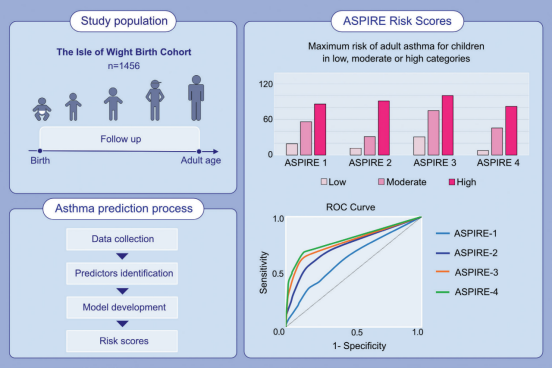Allergy 應(yīng)用新型成人哮喘預(yù)測風(fēng)險評分預(yù)測兒童早期成人哮喘風(fēng)險
發(fā)布日期:2023-10-25
——浙大迪迅 譯
背景:目前已經(jīng)開發(fā)了許多風(fēng)險評分來預(yù)測兒童哮喘。然而,他們可能無法預(yù)測兒童以后的哮喘。本研究的目標是創(chuàng)建兒童風(fēng)險評分,以預(yù)測哮喘的發(fā)展和持續(xù)到成年的生活。
方法:對懷特島出生隊列(n = 1456)進行前瞻性評估,直至26歲。根據(jù)前4年的因素制定哮喘預(yù)測評分,使用logistic回歸并測試敏感性、特異性和曲線下面積(AUC),用于預(yù)測(i) 18和(ii) 26歲時的哮喘,(iii) 10和18歲時的持續(xù)性哮喘(PA), (iv) 10、18和26歲的哮喘。模型在內(nèi)部和外部進行了驗證。
結(jié)果:生成了四個模型來預(yù)測每種哮喘的結(jié)果。哮喘預(yù)測風(fēng)險評分(ASPIRE)-1: 18歲哮喘的2因素模型(復(fù)發(fā)性喘息[RW]和4歲皮膚點刺試驗陽性[+SPT])(敏感性:0.49,特異性:0.80,AUC: 0.65)。ASPIRE-2: 26歲哮喘的3因素模型(RW、+SPT和母鼻炎)(敏感性:0.60,特異性:0.79,AUC: 0.73)。ASPIRE-3: PA-18的3因素模型(RW, +SPT和4年濕疹)(敏感性:0.63,特異性:0.87,AUC: 0.77)。ASPIRE-4: PA-26的3因素模型(RW, 4年+SPT, 2年復(fù)發(fā)性胸部感染)(敏感性:0.68,特異性:0.87,AUC: 0.80)。在外部復(fù)制ASPIRE-1和ASPIRE-3評分。進一步的評估表明,ASPIRE-1可以代替ASPIRE-2-4,具有相同的預(yù)測準確性。
結(jié)論:ASPIRE評分可預(yù)測持續(xù)性哮喘直至年輕人。

原始出處
Allergy
[IF:14.71]
Prediction of adult asthma risk in early childhood using novel adult asthma predictive risk scoresDOI: 10.1111/all.15876
Abstract:
Background:Numerous risk scores have been developed to predict childhood asthma. However, they may not predict asthma beyond childhood. We aim to create childhood risk scores that predict development and persistence of asthma up to young adult life.
Methods:The Isle of Wight Birth Cohort (n?=?1456) was prospectively assessed up to 26?years of age. Asthma predictive scores were developed based on factors during the first 4?years, using logistic regression and tested for sensitivity, specificity and area under the curve (AUC) for prediction of asthma at (i) 18 and (ii) 26?years, and persistent asthma (PA) (iii) at 10 and 18?years, and (iv) at 10, 18 and 26?years. Models were internally and externally validated.
Results:Four models were generated for prediction of each asthma outcome. ASthma PredIctive Risk scorE (ASPIRE)-1: a 2-factor model (recurrent wheeze [RW] and positive skin prick test [+SPT] at 4?years) for asthma at 18?years (sensitivity: 0.49, specificity: 0.80, AUC: 0.65). ASPIRE-2: a 3-factor model (RW, +SPT and maternal rhinitis) for asthma at 26?years (sensitivity: 0.60, specificity: 0.79, AUC: 0.73). ASPIRE-3: a 3-factor model (RW, +SPT and eczema at 4?years) for PA-18 (sensitivity: 0.63, specificity: 0.87, AUC: 0.77). ASPIRE-4: a 3-factor model (RW, +SPT at 4?years and recurrent chest infection at 2?years) for PA-26 (sensitivity: 0.68, specificity: 0.87, AUC: 0.80). ASPIRE-1 and ASPIRE-3 scores were replicated externally. Further assessments indicated that ASPIRE-1 can be used in place of ASPIRE-2-4 with same predictive accuracy.
Conclusion:ASPIRE predicts persistent asthma up to young adult life.
First Author:
Abdal J. Farhan
Corresponding author:
Hasan Arshad
Correspondence: S. NIHR Biomedical Research Centre, MP 810, F Level, South Block, Southampton General Hospital, Tremona Road, Southampton, SO16 6YD, UK.
Email: sha@soton.ac.uk
 杭州浙大迪迅生物基因工程有限公司
杭州浙大迪迅生物基因工程有限公司

